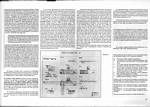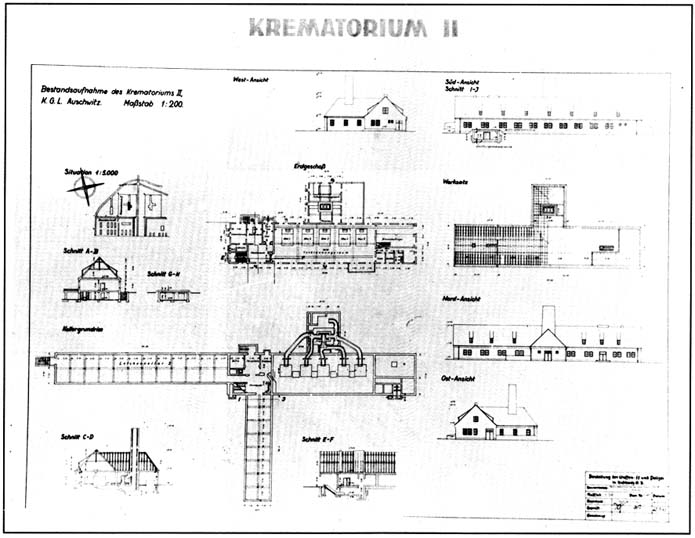|
|
 |
 |
AUSCHWITZ:
Technique
and Operation
of
the Gas Chambers © | |
|
| |
 |
Back |
 |
Contents |
Page 227 |
 |
Home
Page |
Forward |
 |
| |
received by the four Krematorien WAS ONLY SLIGHTLY
MORE THAN THAT REQUIRED FOR 14 MUFFLES OUT OF 46 (including March
1943, the result changes very little, being slightly over 15
muffles). From April to October 1943 Krematorium II, III, IV, and
V worked the equivalent of only TWO MONTHS at full capacity (out
of seven). Admittedly, they incinerated the corpses of between
165,000 and 215,000 victims during that time, but it is apparent
from the files that Birkenau was OVER equipped with cremation
capacity, because until the end of October 1943 they were used to
ONLY A QUARTER OR A THIRD OF THEIR MAXIMUM CAPACITY (which means
that the 15 incineration muffles of JUST ONE installation of the
Krematorien II/III type or the 16 muffles of Krematorien IV AND V
would have amply sufficed for the incineration of the corpses from
the extermination of the Jews and that two Krematorien, II and
III, or three Krematorien, III, IV and V were superfluous to
requirements). This over supply of cremation capacity is confirmed
by Camp Commandant Hoess in his autobiography ["Commandant
of Auschwitz", Pan Books 1961, page
216] |
| |
“Number III [Kr IV] failed completely after a
short time and later ceased to be used altogether. Number IV
[Kr 5] had to be repeatedly shut down, since after its fires
had been burning for from four to six weeks, the ovens or the
chimneys burnt out. The gassed bodies were mostly burnt in
pits behind crematorium IV [Kr V]” [is, fact this was the
situation only in the summer of 1944 during the extermination
of the Hungarian
Jews].” |
It should be noted that before May 1944 the SS made no
attempt to repair Krematorien IV said V, considering (and the coke
consumption figures prove it) that ON THEIR OWN the 30 muffles of
Krematorien II and III [the 6 of Kr I finally having been
withdrawn from service] were AMPLY SUFFICIENT for “routine”
extermination. The only major repair undertaken was that of the
Krematorium II chimney, in May to July 1943, as at this time the
SS could not let their cremation capacity tend towards zero. In
the author’s opinion, the excess cremation capacity al Birkenau,
which remained a constant feature even during the extermination of
the Hungarians, was due to two factors: first, the absolute panic
that seized the SS in July/August 1942 when they were confronted
with a raging typhus epidemic and were in a situation where they
had to combat this by every possible means and at the same time
urgently find an “industrial” technique for large-scale
extermination; second, the influence of Topf engineer Prüfer, a
born fighter who new how to profit from the SS panic and appear as
their savior, selling them all he could and taking a profit for
himself.] |
| |
On Saturday 13th March, after a working day of
FOURTEEN HOURS during which Messing put the finishing touches to the
job, the ventilation and air extraction systems of Krematorium II
Leichenkeller 1 WERE FINALLY DECLARED “FIT FOR
SERVICE”.
ON SUNDAY 14TH MARCH, Messing
continued installing the ventilation of Leichenkeller 2, which he
called “Auskleiderkeller II/ Undressing cellar II”. IN THE
EVENING, ABOUT 1,500 JEWS FROM THE CRACOW GHETTO WERE THE FIRST
VICTIMS TO BE GASSED IN KREMATORIUM II. They did not undress in
Leichenkeller 2, still cluttered with tools and ventilation
components, but in a stable-type hut temporarily erected in the
north yard of the Krematorium [Document 37].
On 17th
March, Jährling again calculated the theoretical daily coke
consumption of the four Birkenau Krematorien, this time without any
errors: 7.84 tons for 12 hours (one day of operation) [Document
33].
In view of the approaching date for the official
handover of Krematorium II, the Bauleitung Drawing Office produced
an inventory drawing on 19th March, drawing 2197, to be attached to
the deed of transfer. Drawing 2197 to a large extent copied drawings
932,933, 934, 936 [937, 938]. 980, 1173 1174 and 1311, bringing them
all together and modifying them according to the changes since made
(but not completely). Three versions of 2197 were produced, with the
differences concerning only the “Kettergnandriss/ Basement plan”
[see these drawings in annex]. The most complete is 2197[b](r),
showing the building's drainage (inspired by 1300) and lighting
systems, This drawing is essential for understanding the
inventories, attached to the deed of transfer, describing the
equipment installed on each floor of Krematorium II, and it even
makes it possible to correct an error on one of these inventories.
One of the two commissions of enquiry (probably the Polish
Commission) had 2197 redrawn after the war, because it is barely
legible [Document 38]. On the same day. Huta requested their
site superintendent at Auschwitz, Herr Stephan, to find out which of
his workers had worked on the night shifts instituted to complete
Krematorium II, and for how long, so that this nightwork could be
invoiced to the Bauleitung, who had ordered it. On 19th March the
Bauleitung drew up the “Ubergabeverhandlung / Deed of transfer” for
the handover of Krematorium IV to the KL Auschwitz Administration.
Accepted on 22nd March, Krematorium IV was officially the first
Birkenau Krematorium to come into “action” (built in five months and
completed less than seven months after being designed), In actual
fact, the furnaces of Krematorium II had been operational since the
beginning of March and the gas chamber since the 14th.
On
24th March, the engineers Prüfer and Schulze, summoned by the
Bauleitung, arrived at Auschwitz to find a solution to the problems
encountered in the operation of Krematorium II during the first
gassings (1,500 Jews from Cracow) the on the 14th and 2,200 from
Saloniki on 20th). A summary record of this meeting, which lasted
two days, was compiled by Kirschneck on 25th [Documents 39].
There was bad news for Topf: the famous forced draught
installations, which had done nothing but cause problems, were to be
dismantled. This decision meant that the installations planned for
Krematorium III were to be abandoned and the planned preheating of
Leichenkeller I was no longer possible. Also, a more substantial
blower casing, in cast iron, was to replace the wooden one in place,
probably to prevent leakage. Finally, the corpse charging trolley
(of the type used in Krematorium I) was to be abandoned in favor of
the easier to use “Leichentrag [or Leichenbrett] / Corpse stretcher
[or board]”. As a result the rails running along the furnace room
and carrying the turntable were removed and replaced by a concrete
trough which was kept full of water to make it easier to drag the
corpses from the lift to the furnaces. The rails in front of the
furnaces, however, were left in place even though now redundant
[Documents 40, 41, 42 and 43]. During Prüfer and Schulze’s
stay at the camp, almost 2,000 Jews from the Saloniki ghetto were
gassed on 24th and a further 1,200 on 25th. The two engineers must
have witnessed this, in view of their degree of involvement in the
homicidal installations of Krematorium II.
[Document
39, the summary record of the meeting of 25th March 1943, is a
"criminal trace" concerning the existence of homicidal gas
chambers.]
On 29th March. Jährling, on behalf of the
Bauleitung, confirmed to Topf by letter that the wooden case or
housing of the two air extractor fans (for the Leichenkeller 1 of
Krematorien II and III) were to be replaced by a cast iron model.
From 29th to 31st March, Messing was completing the installation of
the undressing room ventilation system, which became operational on
31st.
On 30th March, Kirschneck wrote a brief note to the
effect that SS Second Lieutenant Eggeling (an agricultural engineer)
was to be responsible for all water supply and drainage work for
Krematorium III. |
| |
[The drainage system of Krematorium III was simplified
as compared with that of Krematorium II. For example, the Kr II
gas chamber [Leichenkeller 1] sewer manhole was brick built with
an internal iron ladder, whereas in Kr III it was simply a few
sections of low cost concrete pipe [Documents 44, 45, 46, 47
and 48]. In the author's opinion, this type of simplification
of construction, based on the experience of building Krematorium
II, was used wherever possible in Krematorium III, which probably
explains its lower overall cost: 554,550 RM for Kr III, as against
probably 646,000 RM for Kr II.] |
| On 31st March, KREMATORIUM II WAS OFFICIALLY ACCEPTED
BY THE CAMP ADMINISTRATION. |
|
| |
| Document 38 |
 |
|
| |
[When a Krematorium was handed over to the camp
administration, the Bauleitung compiled a set of documents
comprising: |
| |
| A. |
The deed of transfer
(“Ubergabeverhandlung”) |
| B. |
A description of the building
(“Gebüadebeschreibung”) [this was in fact on the verso of the above,
A and B being a single sheet]. |
| C. |
An inventory drawing
("Bestandsaufnahme") of the building on a scale of 1:200 (Kr II and
III) or 1:100 (Kr IV and V). |
| D. |
Three inventories (basement,
ground floor, roof space) indicating the nature and number of
electrical, sanitary or other installations on each floor for Kr II
and III (3 sheets), or just one inventory (ground floor) for Kr IV
and V (I sheet). |
| E. |
The construction contract
("Bauantrag") with an explanatory report ("Erläuterungsbericht") (2
sheets). |
| F. |
A summary of the expenses
incurred and the total cost of the building ("Kostenverschlag") (2
sheets). |
| |
In theory, such a file should have been handed over
each time one of the Krematorien was accepted, making a total of
32 documents and drawings. However, only 20 documents, are known
at present:
Krematorium II: A, B, C, D (E and F missing. C
is drawing 2197).
Krematorium III: A, D, E, F (B and C
missing. Probably no specific drawing).
Krematorium IV: A, C,
D E F (B missing. C is drawing 2036)
Krematorium V: (All
documents missing. Probably no specific drawing).
The
known documents are preserved in PMO File BW 30/43.]
| |
| |
AUSCHWITZ:
Technique
and operation
of the gas chambers
Jean-Claude Pressac
© 1989, The
Beate Klarsfeld Foundation |
 |
Back |
Page 227 |
Forward |
 |
|

